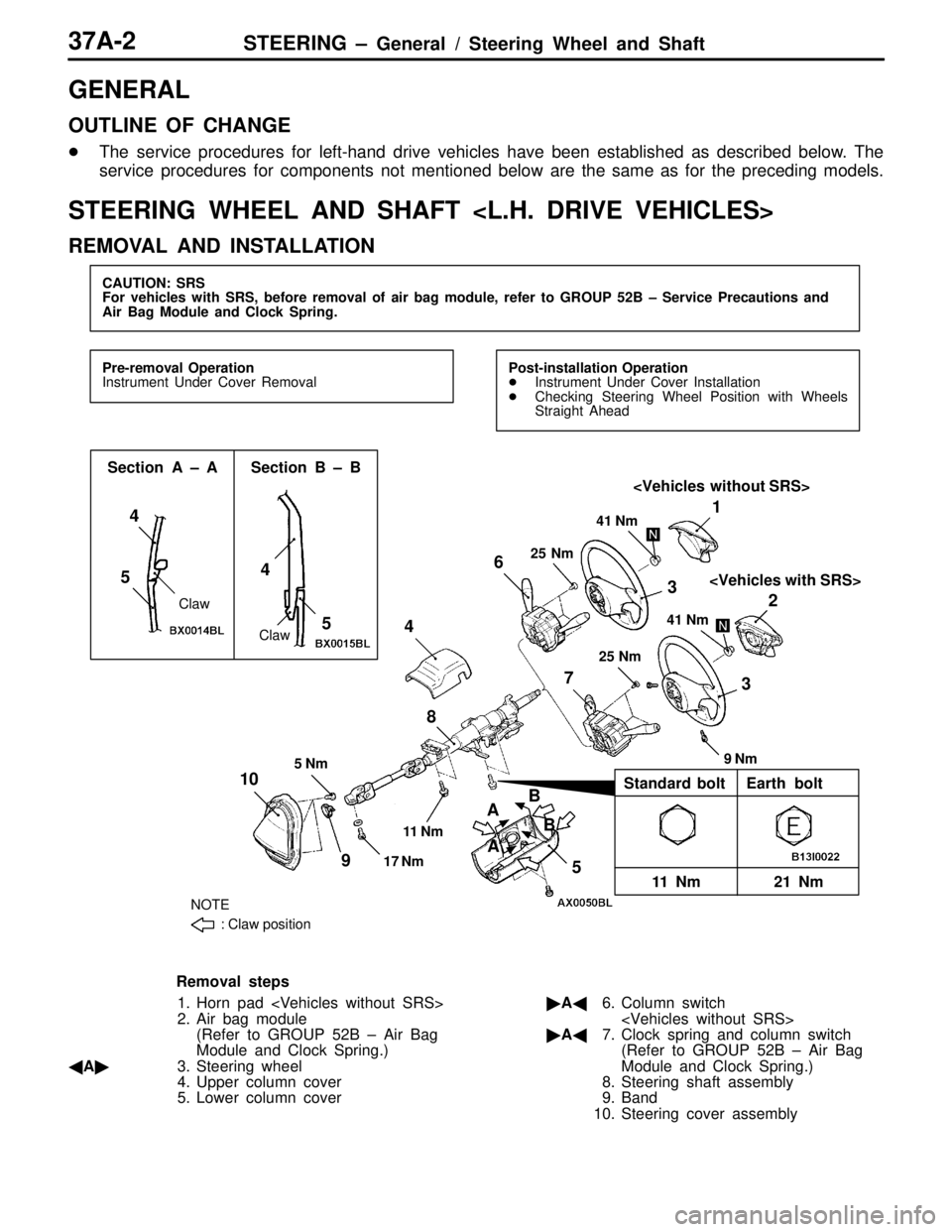Page 239 of 558
FRONT SUSPENSION – General / Lower Arm 33A-1
GROUP 33A
FRONT SUSPENSION
GENERAL
OUTLINE OF CHANGE
�The installation method of the ball joint between the knuckle and the lower arm has been changed,
and accordingly the removal and installation procedures of the lower arm have been revised.
LOWER ARM
REMOVAL AND INSTALLATION
Caution
The part marked with * should be first temporarily tightened, then torqued to specification with the vehicle
on the ground in unloaded condition.
Post-installation Operation
�Push the Dust Cover of the Lower Arm and Stabilizer Link Ball Joint with a Finger to Check for Possible Cracks or Damage.
�Wheel Alignment Check and Adjustment
1
2
3
4
5
6
39 Nm
106 Nm*
5
98 – 118 Nm
74 – 87 Nm88 Nm
137 Nm
Removal steps
1. Stabilizer link mounting nut
2. Bolt
3. Stabilizer bracket
�A�4. Bushing assembly
5. Lower arm assembly6. Lower arm bracket assembly
NOTE
Follow the conventional procedures for installation service
points.
Page 241 of 558
35A-1
BASIC BRAKE
SYSTEM
CONTENTS
GENERAL 2. . . . . . . . . . . . . . . . . . . . . . . . . . . . . . .
Outline of Change 2. . . . . . . . . . . . . . . . . . . . . . . . .
ON-VEHICLE SERVICE 2. . . . . . . . . . . . . . . . . .
Brake Pedal Check and Adjustment 2. . . . . . . .
BRAKE PEDAL 4. . . . . . . . . . . . . . . . . . . . . . . . . . MASTER CYLINDER AND BRAKE
BOOSTER 5. . . . . . . . . . . . . . . . . . . . . . . . . . . . . . .
Master Cylinder 7. . . . . . . . . . . . . . . . . . . . . . . . . . .
DISC BRAKE 9. . . . . . . . . . . . . . . . . . . . . . . . . . . .
Page 242 of 558

BASIC BRAKE SYSTEM – General / On-vehicle Service35A-2
GENERAL
OUTLINE OF CHANGE
�The service procedures for left-hand drive vehicles have been established as described below.
�The service procedures for the front and rear disc brakes have been changed since they had been
replaced by a different type.
ON-VEHICLE SERVICE
BRAKE PEDAL CHECK AND ADJUSTMENT
1. Turn up the carpet, etc under the brake pedal.
2. Measure the brake pedal height as illustrated. If the brake
pedal height is not within the standard value, follow the
procedure below.
Standard value: 163.5 –166.5 mm
(1) Disconnect the stop lamp switch connector.
(2) Adjust the brake pedal height by turning the operating
rod with pliers (with the operating rod lock nut
loosened), until the correct brake pedal height is
obtained.
(3) Secure by tightening the lock nut of the operating
rod.
(4) Push the stop lamp switch in the direction of the
pedal stroke until it stops. (The switch will slide if
it is pushed firmly.)
(5) Lift up the pedal until the operating rod is fully
extended, and then slide the stop lamp switch back
to the required position. Adjust the position of the
switch by turning it until the distance shown in the
illustration is correct.
(6) Connect the connector of the stop lamp switch.
(7) Check that the stop lamp is not illuminated with the
brake pedal unpressed.
3. With the engine stopped, depress the brake pedal two
or three times. After eliminating the vacuum in the power
brake booster, press the pedal down by hand, and confirm
that the amount of movement before resistance is met
(the free play) is within the standard value range.
Standard value: 3 – 8 mmOperating
rod
Operating
rod lock nutStop lamp
switch
Pedal down
Pedal up
Lock nut
Lock nut
Outer case
0.5 – 1.0 mm
Page 243 of 558
BASIC BRAKE SYSTEM – On-vehicle Service35A-3
If the free play exceeds the standard value, it is probably
due to excessive play between the retaining ring bolt
and brake pedal arm.
Check for excessive clearance and replace faulty parts
as required.
4. Start the engine, depress the brake pedal with
approximately 490 N of force, and measure the clearance
between the brake pedal and the floorboard.
Standard value: 80 mm or more
If the clearance is outside the standard value, check for
air trapped in the brake line, clearance between the lining
and the drum and dragging in the parking brake.
Adjust and replace defective parts as required.
5. Turn back the carpet, etc.
Page 246 of 558
BASIC BRAKE SYSTEM – Master Cylinder and Brake Booster35A-6
INSTALLATION SERVICE POINTS
�A�VACUUM HOSE CONNECTION
Insert securely and completely until the vacuum hose at the
engine side contacts the edge of the hexagonal part of the
fitting, and then secure by using the hose clip.
�B�CLEARANCE ADJUSTMENT BETWEEN BRAKE
BOOSTER PUSH ROD AND PRIMARY PISTON
Calculate clearance A from the B, C and D measurements.
A = B – C – D
Standard value: 0.65–0.85 mm
If the clearance is not within the standard value range, adjust
by changing the push rod length by turning the screw of
the push rod.
Measuring
distance BMeasuring
distance D
Block
gaugeB
AC
D
Page 248 of 558
BASIC BRAKE SYSTEM – Master Cylinder and Brake Booster35A-8
DISASSEMBLY SERVICE POINTS
�A�PISTON STOPPER BOLT DISASSEMBLY
Remove the piston stopper bolt, while depressing the piston.
�B�PISTON STOPPER RING DISASSEMBLY
Remove the piston stopper ring, while depressing the piston.
INSPECTION
�Check the inner surface of master cylinder body for rust
or pitting.
�Check the primary and secondary pistons for rust, scoring,
wear, damage or wear.
�Check the diaphragm for cracks and wear.
Page 251 of 558

37A-1
STEERING
CONTENTS
GENERAL 2. . . . . . . . . . . . . . . . . . . . . . . . . . . . . . .
Outline of Change 2. . . . . . . . . . . . . . . . . . . . . . . . .
STEERING WHEEL AND SHAFT* 2. . . . . . . .
POWER STEERING GEAR BOX* 5. . . . . . . . .
WARNINGS REGARDING SERVICING OF SUPPLEMENTAL RESTRAINT SYSTEM (SRS) EQUIPPED VEHICLES
WARNING!
(1) Improper service or maintenance of any component of the SRS, or any SRS-related component, can lead to personal
injury or death to service personnel (from inadvertent firing of the air bag) or to the driver and passenger (from rendering
the SRS inoperative).
(2) Service or maintenance of any SRS component or SRS-related component must be performed only at an authorized
MITSUBISHI dealer.
(3) MITSUBISHI dealer personnel must thoroughly review this manual, and especially its GROUP 52B – Supplemental
Restraint System (SRS) before beginning any service or maintenance of any component of the SRS or any SRS-related
component.
NOTE
The SRS includes the following components: SRS-ECU, SRS warning lamp, air bag module, clock spring and interconnecting
wiring. Other SRS-related components (that may have to be removed/installed in connection with SRS service or maintenance) are
indicated in the table of contents by an asterisk (*).
Page 252 of 558

STEERING – General / Steering Wheel and Shaft37A-2
GENERAL
OUTLINE OF CHANGE
�The service procedures for left-hand drive vehicles have been established as described below. The
service procedures for components not mentioned below are the same as for the preceding models.
STEERING WHEEL AND SHAFT
REMOVAL AND INSTALLATION
CAUTION: SRS
For vehicles with SRS, before removal of air bag module, refer to GROUP 52B – Service Precautions and
Air Bag Module and Clock Spring.
Pre-removal Operation
Instrument Under Cover RemovalPost-installation Operation
�Instrument Under Cover Installation
�Checking Steering Wheel Position with Wheels
Straight Ahead
5 Nm
17 Nm11 Nm
10
98 431
532
41 Nm
25 Nm
6
25 Nm41 Nm
7
9 Nm
Section A – A Section B – B
Claw
: Claw position
AB 4
5
AB
11 Nm 21 Nm Standard bolt Earth bolt
NOTE
4
5
Claw
Removal steps
1. Horn pad
2. Air bag module
(Refer to GROUP 52B – Air Bag
Module and Clock Spring.)
�A�3. Steering wheel
4. Upper column cover
5. Lower column cover�A�6. Column switch
�A�7. Clock spring and column switch
(Refer to GROUP 52B – Air Bag
Module and Clock Spring.)
8. Steering shaft assembly
9. Band
10. Steering cover assembly